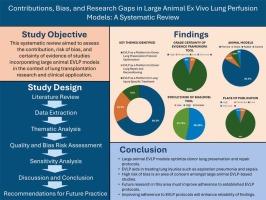Contributions, bias, and research gaps in large animal ex vivo lung perfusion models: A systematic review
引用次数: 0
Abstract
Background
A major challenge in lung transplantation is the shortage of viable donor lungs. Ex vivo lung perfusion (EVLP) has emerged as an effective assessment and conditioning tool to expand the donor lung pool. This systematic review sought to establish the contribution of large animal models to EVLP development and application, particularly focusing on assessing the risk of bias and the certainty of evidence.
Methods
A strategic literature search was conducted using a predefined pro forma. Relevant data were extracted, and thematic analysis was applied for qualitative synthesis of key measures. Methodological quality and bias risk were assessed using systematic review centre for laboratory animal experimentation’s risk of bias tool, and certainty of evidence was evaluated using the grading of recommendations assessment, development and evaluation Framework.
Results
A total of 32 studies met the inclusion criteria, using porcine, ovine, rabbit, and canine models. Key themes included EVLP’s role in donor lung assessment and preservation, marginal donor lung repair, and as an experimental translational platform. All studies were assessed with the systematic review centre for laboratory animal experimentation tool and had a high or unclear risk of bias. Twenty-eight (87.5%) showed low certainty of evidence, 2 (6.25%) very low, and 2 (6.25%) moderate, raising concerns about overall evidence strength.
Conclusions
Large animal EVLP models have significantly advanced donor lung preservation, reconditioning, and therapeutic intervention. However, methodological bias remains a concern due to inconsistent adherence to reporting and procedural standards. Greater conformity to standardized protocols is pivotal to improve the reliability, reproducibility, and translational value of future EVLP research.

大型动物离体肺灌注模型的贡献、偏倚和研究空白:系统综述
肺移植的一个主要挑战是缺乏可行的供肺。体外肺灌注(EVLP)已成为一种有效的评估和调节工具,以扩大供体肺池。本系统综述旨在确定大型动物模型对EVLP开发和应用的贡献,特别侧重于评估偏倚风险和证据的确定性。方法采用预先确定的格式进行策略性文献检索。提取相关数据,运用专题分析对关键指标进行定性综合。采用实验动物实验偏倚风险系统评价中心工具对方法学质量和偏倚风险进行评估,采用建议评估分级、发展和评价框架对证据的确定性进行评估。结果共有32项研究符合纳入标准,采用猪、羊、兔和犬模型。关键主题包括EVLP在供肺评估和保存,边缘供肺修复中的作用,以及作为实验翻译平台。所有研究均由实验动物实验工具系统评价中心进行评估,存在较高或不明确的偏倚风险。28份(87.5%)证据确定性较低,2份(6.25%)证据确定性极低,2份(6.25%)证据确定性中等,对总体证据强度提出了担忧。结论大动物EVLP模型具有明显的供肺保存、修复和治疗干预能力。然而,由于不一致地遵守报告和程序标准,方法偏差仍然是一个问题。更大程度地符合标准化协议对于提高未来EVLP研究的可靠性、可重复性和转化价值至关重要。
本文章由计算机程序翻译,如有差异,请以英文原文为准。
求助全文
约1分钟内获得全文
求助全文

 求助内容:
求助内容: 应助结果提醒方式:
应助结果提醒方式:


